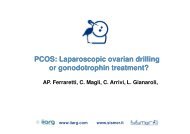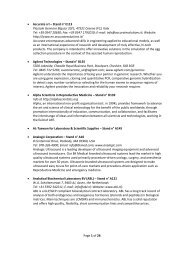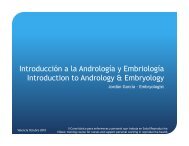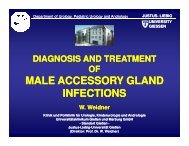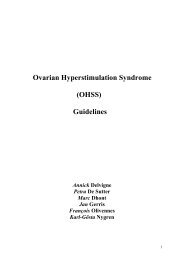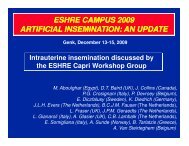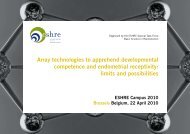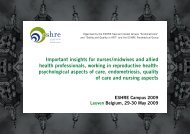here - eshre
here - eshre
here - eshre
- No tags were found...
Create successful ePaper yourself
Turn your PDF publications into a flip-book with our unique Google optimized e-Paper software.
eplication in blood and semen, butsome infected men maintain substantialviral concentrations in their semen, evenin the presence of undetectable bloodplasma viral load with antiretroviraltreatment. 18 Certain studies have shownthat HIV-RNA may be amplified insemen when undetectable in plasma in2–8% of patients on HAART,suggesting that the genital tract mayrepresent a separate reservoir for viralreplication. 19,20 Genital tract infectionsaccount for a significant number ofepisodes of HIV genital shedding andtheir eradication is followed by areduction in the HIV concentration ingenital fluids. 21Screening for genital tract infection,for semen and ovulatory quality and fortubal patency should be performedbefore treatment to select the mostappropriate reproductive technologyand to minimise the number oftreatment cycles. Some observationshave suggested an increased prevalenceof infertility factors in couples with HIV, which canprolong the time (and number of attempts) to achievefertilisation; this may increase the risk of sexualtransmission, or make conception impossible, as in the caseof severe dyspermia or tubal disease. In the latter cases,such couples are exposed to a risk of infection without thechance of conception.Reproductive techniques in HIV-infected couplesSpermatozoa tested for the absence of HIV contaminationcan be used for fertilisation by IUI or IVF/ICSI in HIVdiscordantcouples with male infection. The technology,used in conjunction with semen washing, should minimisepotential damage to the healthy female while providing agood fertility rate.Semen washing was developed more than 15 years agoand consists of a three-step method to remove infectedseminal leukocytes and wash the spermatozoa free ofseminal plasma. 22 Other pioneering centres in Europe havestarted their own sperm washing programmes, which hasnow culminated in a European network of units providingassisted conception to HIV-discordant couples. These andother centres are now linked in CREAThE, a network ofclinics covering Italy, Spain, UK, Germany, Russia,Switzerland, France, Belgium and Israel to optimisetreatment and monitor outcomes.A systematic review of 658 abstracts (of which only 41were selected for analysis) and 17 full articles has just beenpublished. 23 The review included 3900 IUI cycles in 1184couples in 11 studies, and 738 ICSI/IVF cycles in 579couples across ten studies. The IUI and ICSI results were,respectively: pregnancy rates per cycle 18% and 38.1%;The risk of viral transmission from an HIV +ve male to his uninfected partner and futurechild can be virtually removed by ART with washed sperm. Sperm washing is based onthe observation that the HIV virus cannot attach itself to spermatozoa, but can be foundin the fluid and cells surrounding spermatozoa. Sperm washing allows the separation oflive sperm from the surrounding fluid and cells in a three-step process: 1, a spermatozoamigration on density gradient; 2, repeated washing of the migrated pellet; and 3, aspermatozoa swim up.cumulative pregnancy 50% and 52.9%; and abortion rate15.6% and 20.6%. No seroconversions in women ornewborns were detectable at birth or after 3-6 months.HIV-infected women have additional special needs insexual and reproductive health, including information andservices to protect their own health as well as to reduce therisk of mother-to-child HIV transmission. The number ofspecialists ready to offer these services to HIV-positivewomen with fertility problems has been increasing since1993. 24 And today t<strong>here</strong> is a general willingness to treatHIV-infected women with ART, given the low risk of HIVvertical transmission.A reduced pregnancy rate after IVF has been observed inHIV-infected women when the patient’s own oocytes wereused. However, no significant reduction in pregnancy ratewas found when donated oocytes were used. It has beensuggested that subclinical hypogonadism mediated byimmunosuppression may explain these observations. It isalways important to optimise the woman’s HIVimmunological status before considering ART. The mostrecent studies report clinical pregnancy rates per cyclevarying from 11-21% in HIV-1-infected women after IVFor ICSI, compared with 26% in matched controls. Thepaucity of data reported on IVF and ICSI cycles in HIV-1-infected women do not allow any further conclusion. 25It is now well accepted that couples in whom one or bothpartners are HIV infected should have access to the samefertility advice and treatment as non-infected individuals toallow them to conceive, and to do so with the minimum ofrisk to their partners or children.Reproductive counselling to individuals with HIV mightFocus on Reproduction January 2012 33




